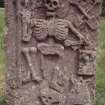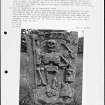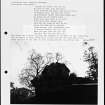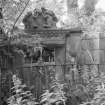Crailing House, Old Burial Ground
Burial Ground (Medieval), Church (Medieval)
Site Name Crailing House, Old Burial Ground
Classification Burial Ground (Medieval), Church (Medieval)
Alternative Name(s) Crailing Churchyard
Canmore ID 57040
Site Number NT62SE 3
NGR NT 68847 24261
Datum OSGB36 - NGR
Permalink http://canmore.org.uk/site/57040
- Council Scottish Borders, The
- Parish Crailing
- Former Region Borders
- Former District Roxburgh
- Former County Roxburghshire
NT62SE 3 68847 24261.
(NT 6884 2426) Church (NR) (Ruin).
OS 6"map, Roxburghshire, (1923).
Crailing Church. This church has been an oblong single-chambered building measuring about 75ft in length by 25ft in breadth; but only the NW. corner remains standing, the walls being elsewhere no more than 4ft 6in in height with a thickness of 2ft 7 1/2in. Sufficient is left, however, to indicate that an outbuilding abutted against the W. gable. The only surviving window is a small 17th-century light facing N. The following memorials were noted in the church-yard:
(1) A small headstone commemorating ROBERT ROBSONE IN THE YET, who died in 1697.
(2) A small headstone commemorating JAMES WOOD PORSHINER IN CREALING, who died in 1699.
(3) A small headstone commemorating JAN(?ET) SPOVSE TO JOHN ROBSONE. The stone is badly weathered and the date illegible, but the lettering suggests the turn of the 17th and 18th centuries.
(4) A small headstone inscribed HERE LYES RO/BERT HELEN AND / ISSOBEL WOODS CH/ILDREN TO JOHN WOOD SMITH IN ECK/FOORD 1699.
In addition to the foregoing, the graveyard contains two headstones bearing human figures (RCAHMS 1956, fig.27); dates have vanished, but the clothing of the figures suggests that they may fall within the period of the Inventory. Both wear breeches and long coats, one of these having turned-up sleeves and no collar. This latter figure also has a flat cap and a stick. Other badly weathered and undated stones, possibly earlier than 1707, include a large and a small headstone bearing the emblems of mortality.
RCAHMS 1956, visited 6 August 1931, 24 October 1944.
"In this church David Calderwood, the famous patriot and ecclesiastical historian, commenced his adventurous career in 1604 ... it was dismantled in 1754, when the parishes of Crailing and Nisbet were united."
W Brydon 1952.
As described by RCAHMS. The outline of the church cannot be traced with any certainty.
Visited by OS(WDJ) 17 January 1967.
NT 6887 2426 For the launch Scottish Archaeology Month 2014, Archaeology Scotland commissioned an initial assessment of the cultural significance of the churchyard. The local community were supervised, 10–17 August 2014, in a vegetation site clearance within the churchyard following a vegetation habitat survey by Ben Averis and resistivity survey by EAFS in the surrounding area. The gravestones and monuments were photographed and mapped onto a sketch plan and a summary research report was produced by graveyard expert Susan Buckham.
Archive: RCAHMS (intended)
Funder: Scottish Borders Council
Lesley McEwan – Archaeology Scotland
(Source: DES)
Earth Resistance Survey (10 August 2014)
NT 6887 2426 As part of a programme of work arranged by Archaeology Scotland, a ground resistance survey was carried out on 10 August 2014 in the field surrounding Crailing Old Church. The area included part of the old burial ground, which appears as a platform above the surrounding
pasture. The results were inconclusive as to definite features, though the platform corresponding to the graveyard showed a generally higher resistance than the surrounding field. Archive: RCAHMS and Scottish Borders Council SMR (intended)
Funder: Archaeology Scotland and Edinburgh Archaeological Field Society
Don Matthews – Edinburgh Archaeological Field Society
(Source: DES)




















































